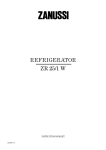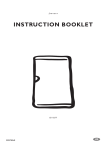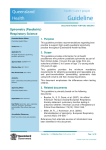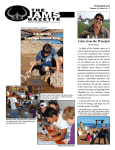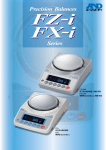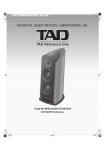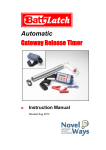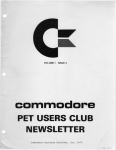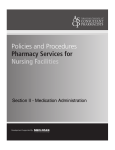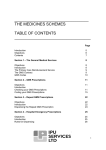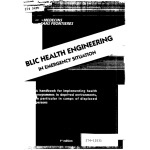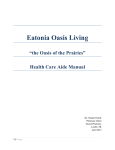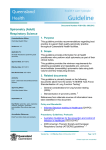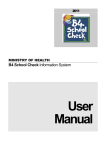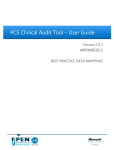Download Come and see us at our new premises Issue Highlights
Transcript
Asthmalink Newsletter of Asthma & Respiratory Services (Waikato) Inc Te Ha Ora Huango June 2010 Come and see us at our new premises We’re thrilled to have moved to our larger premises on Pembroke Street. With the increase in demand for our services we were finding it increasingly difficult to operate from our old Asthma Centre in Nawton. Story continued on page 4. Issue Highlights Bronchiolitis - Symptoms and Care Facts on Spacers Asthma Waikato Relocated Mouth Breathing News, views and home truths to encourage and inform people with breathing difficulties Asthmalink June 2010 How we have helped Bronchiolitis I recently had a call from a Mum whose baby of a few months of age was coughing, wheezing and becoming quite irritable at times. He was still drinking well but taking smaller feeds more frequently and she was up to him several times during the night. 2 days previously, he been to the hospital and had had a chest X-ray which was clear. The Mum wanted a nebulizer so she could vaporize eucalyptus to help him to breathe. I could hear the child coughing, wheezing and grizzling in the background while Mum was on the phone. He would settle briefly for a few minutes and then start up again. I was concerned and felt that Mum should take him back to the doctor. She felt that as he had only been seen 2 days previously that a return visit was unnecessary because the X-ray was clear and the doctor had told her that baby could take a couple of weeks to recover. However as he had got a bit worse and his feeding pattern had changed, she agreed to see her GP. The baby was admitted to hospital for 2 days on oxygen and Mum rang us back to say she was so pleased that she had rung us and listened to our advice. Val Hollands - Respiratory Nurse If you have any worries about your baby, give us a call to talk about their symptoms or take baby back to see your GP. There is further information on bronchiolitis on page 5. BRONCHIOLITIS TIPS Little babies get sick very quickly and it is ok to go back to the doctor every day if you are unsure or worried about their condition. Write down any changes in breathing patterns, feeding habits, wet nappies or if baby has a fever. The pattern with Bronchiolitis is that babies deteriorate until they hit rock bottom and then slowly improve over several days. It can take a few weeks until they are well again. Asthmatic Child: Mouth breather This client, an 8 year old boy, has been asthmatic since he was 2 years old. His asthma is usually well controlled but over the past few months Mum had noticed his asthma worsening, particularly on exersion or during exercise. His asthma medications are flixotide and ventolin. He was on the top dose for flixotide 200mcg, which he had been on for a good week in an attempt to gain some control over his asthma. Mum was reluctant to give him any flixotide because she was worried he was taking too much steriod. I explained to her he must take flixotide as this will help to protect his lungs by reducing swelling and excess mucous that can plug up the airways. sleeping better at night and his asthma is better controlled. He still has break-through symptoms of shortness of breath but not as frequently, he is also now on serevent (long-acting reliver). Tracy Keelan - Respiratory Nurse If you think your child is a mouth breather or would like more information on mouth breathing then check with your GP or make an appointment to see one of our nurses. On observation I noticed this young man was over-breathing through his mouth. No nasal (nose) breathing was happening as his nose was either congested or he had a possible structural problem going on. Mum told me her son mouth breathes all the time. I explained the implications around mouth breathing for an asthmatic. I also noticed, as a result of mouth breathing, he was using his upper chest to breathe instead of his tummy. He had dark rings below his eyes which also told me he may have possible sinusitis or rhnitis (hay fever). His Mum told me he might have hay fever, but was not entirely sure. I then suggested that she go back to her GP and get her son referred to an Ears Nose and Throat (ENT) specialist. When upper airways (eg. nasal airways) are not working as they should, this can have an effect on lower airways where the lungs sit and can trigger asthma. Since this visit I have followed-up Mum and her son, and he has been seen by an ENT specialist. He is now on medication for reflux. In a month and a half he will return to the ENT specialist to have his adenoids examined. Mum is happy as her son is now 1 HELP IS ONLY A PHONE CALL AWAY - 07 838 0851 Asthmalink Spacers Spacers Spacers Spacers are important if you have an MDI (metered dose inhaler) Recently I had two referrals for children who had ended up in the A & E in the early hours of the morning. Neither child was using their spacer properly. The first child, a 7 year old girl, had a preventer which was used now and then if the asthma was bad and had a reliever which was used a lot. Dad was giving the medication through her spacer but was giving only one puff in total. He was unaware that when asthma symptoms were present he needed to give 6 puffs of reliever medication to open the airways. The one puff every hour gave no improvement, his daughter kept everyone awake during the night and finally they had to dash to the A & E. Everyone was very stressed. Dad phoned the Asthma Centre for help. During my visit I checked their spacer technique, explained about giving more than one puff of reliever per episode (although it is only one puff at a time allowing 6 breaths between puffs) and the importance of using the daily preventer. Six weeks later I checked back and everyone is doing well. The second child, a 12 year old boy, had a preventer, was using it daily but did not have a spacer. He came from overseas where spacers were not in common usage. He did have a nebuliser which was used often. He had a bad turn one night so Mum nebulised him then took off for the A & E. I strongly suggested he get a spacer and take his preventer through it. If he was taking the time to take his medication he may as well do it properly. I also explained that he could use his spacer rather than his nebuliser when having an acute episode. Both these children had caring parents, both had access to medication and health care but neither were using their medications properly. It may be that the dashes to the A & E could have been avoided. Barbara Lawrence - Respiratory Educator If you have any concerns about your childs spacer technique, give us a call. We’re happy to provide education on the correct use of spacers. June 2010 SPIROMETRY TESTING $35 (cheaper for existing clients) Our spirometry technicians are trained and certified by: Respiratory Physiology Laboratory – Christchurch Hospital The Christchurch Spirometry Training Course is a TSANZ and ANZSRS endorsed course This is a great book for children with asthma as it encourages and empowers them to take control of their condition Available from the Asthma Centre $10 each SPACER TIPS Using a spacer can help prevent oral thrush and reduces the amount of medication that gets deposited in the mouth and throat. Using a spacer removes the need to take a deep breath and hold it for 10 seconds when taking inhaled medication. This is especially beneficial when you are feeling unwell and short of breath. A spacer is a plastic tube that puts “space” between the person’s mouth and the medication. Research has shown that there is up to 50% better deposition in the lungs when using a spacer than when inhaling directly into the mouth even if you have the best technique in the world. Most people‘s technique is less than ideal. Using a spacer removes the need for any hand/breath coordination. Just press and breathe at your own pace. A spacer can be as effective as a nebuliser for acute asthma. HELP IS ONLY A PHONE CALL AWAY - 07 838 0851 2 Asthmalink June 2010 News Fundraising Nancy Illing and her sausage sizzling team are seen regularly outside The Warehouse Hillcrest – look out for them over the coming months. The funds raised are an important revenue stream for Asthma Waikato as it enables us to continue to provide ever-improving services to people with respiratory conditions. Balloon Day 2010 was a wonderful success. Schools throughout the region provided photo opportunities for their local newspapers. Thank you to: Matamata Primary School Thames South School Huntly West School St Josephs School, Hamilton Morrinsville Intermediate Our wonderful volunteers once again helped with a stand at Westfield Chartwell raising $836.80 for Asthma Balloon Day. Thanks to the Genesis Energy Employee Volunteering Program we were also fortunate to have a team of fundraisers from Genesis Energy run a street appeal at Garden Place raising $203.70 Cambridge Middle School Tokoroa Intermediate Te Kuiti Primary Matamata Group update Winter is now really with us and some of our group find their breathing more difficult but are still attending our gym group sessions. On the 21st April Barbara Lawrence came and spoke to us on Asthma Medication which we all found very interesting and informative, there was also time for Barbara to speak to several of our members on a one to one basis. We felt we wanted to promote Balloon Day and Asthma awareness in Matamata so we held a bring and buy stall at the local market day held in Matamata. This turned out to be very successful and the support of our members in their bright Asthma shirts went down well. Coming up on the 28th June we are having our annual luncheon at the R.S.A where our guest speaker will be a physiotherapist from Waikato Hospital. Keep warm. Matamata Huffin and Puffin Friends South Waikato Group update Friends, Kiwis, and All, lend me your Years! The year in retrospect for South Waikato, I believe to have been a successful one. We have held 3 meetings to which the public were welcome, to hear a variety of speakers such as diets (not FADS), medications and exercises. For this years Balloon Day our committee decided to try a venue at Countdown, Tokoroa. We did not bother with a sausage sizzle but relied on balloons and smiling faces with collection pails. Result? - An increase of 48 cents over donations received last year - in a period of economic downturn - an excellent result! Many grateful thanks to all who took part. Te Quill 3 HELP IS ONLY A PHONE CALL AWAY - 07 838 0851 Asthmalink June 2010 continued from front page ... In the past 2 years, we have created an additional full time nursing position and have just relocated to larger, more prominent premises at 45 Pembroke Street in the health/professional precinct of Hamilton. What we are finding, is that demand for our services is increasing and we need to increase our capability to provide our community based services. In this climate, we are increasingly dependent on philanthropic support, grant funding and the goodwill of the community who donate various goods, time and money. If you would like to support our work, please do contact us. We would appreciate discussing ways that we can help each other. We have come a long way Our recent move to 45 Pembroke St, Hamilton Lake, Hamilton is our 8th location since becoming an Incorporated Society in 1973. Originally, Asthma Waikato had a base on the Waikato Hospital campus alongside the Rheumatology Department and we needed to relocate as that department expanded. Following that Ian McMichael, Pharmacist, provided a total of five locations, all associated with Pharmacy 547 and we take this opportunity once again to thank Ian for his support over the years. Our previous Asthma Centre in Nawton provided a community based asthma centre for five years and we hope to remain in Pembroke St for many years to come. Asthmalink was proudly designed & print managed by Design Buzz Ltd. This Newsletter is printed on paper from sustainable forests. Manufacturers of all Commercial & Residential Joinery, Stairs, Doors and Shop Fittings 172 Ellis Street, Frankton, Hamilton 3204 Phone: 07-848 1020 Mobile: 0274-903 039 Fax: 07-848 1030 Email: [email protected] Thank you to the team at Concept Joinery for giving up a Saturday morning to help us move TIPS www.designbuzz.co.nz For more information on how Design Buzz can help you with your design & print requirements please feel free to contact us on 07 8555 913 or 021 1500 894 [email protected] Care of your spacer Mouth Breathing It is best to breathe through your nose and to utilise your diaphragm (ie. movement should be more prominent in the tummy than the upper chest.) Do you breathe through your mouth because you have a nasal problem? Common ailments are : hayfever, sinisitis, and post-nasal drip. Sometimes this could be a structural thing eg. problems with adenoids. Ask your doctor or your Asthma Educator whether you need to be referred to an ENT specialist. Spacers are plastic and pick up static energy so medications can just stick to the sides. You need the medicine to stay in the air inside the spacer in order to breathe it in. To stop the medicine sticking to the sides, the spacer needs to be ‘primed’. To prime and clean the spacer: 1. Wash in warm soapy water. 2. Shake excess bubbles (Don’t rinse the spacer) 3. Leave to drip dry. (Don’t dry with a tea towel.) * The detergent bubbles line the plastic so the medicine doesn’t stick to it. Remember: If you have a new spacer, it needs to be primed before you use it for the first time. REMEMBER TO GET YOUR FLU VACCINATION The new Flu vaccine includes H1N1 (Swine Flu) protection and is free to: people over 65 years or who have asthma and are using a preventer medication or have another chronic lung condition. Check with your G.P. to see if you or your children qualify. ** IMPORTANT ** Do you use SPIRIVA? Ask your pharmacist to replace your handihaler annually. The needle inside the handihaler which pierces your medication capsule can go blunt over time, so should be replaced HELP IS ONLY A PHONE CALL AWAY - 07 838 0851 4 Asthmalink June 2010 What you need to know About Bronchiolitis Bronchiolitis is the swelling of the smaller breathing tubes (called Bronchioles) in the lungs. The linings of these tubes become very swollen and blocked with mucous/phlegm. Babies and toddlers are more affected. It is usually caused by a viral infection, more commonly known as RSV (Respiratory Syncytial Virus) Bronchiolitis is usually a disease of young tamariki/children under 2 years. It starts from about 3 – 6 months of age. Although it is often a mild illness (similar to a mild cold) some pepe/babies are at risk of developing a more severe illness requiring hospitalization. Babies with chronic heart & lung disease, prematurity & a weakened immune system due to illness or medication are more at risk. Signs and Symptoms to look for Are similar to a common cold • Runny nose • Mild cough • Sneezing • Stuffy nose • May have a temperature - After 2 or 3 days, breathing may become faster - Your pepe/baby may sound short of breath - Pepe /baby’s breath may whistle (wheeze) - Sometimes pepe/baby’s neck or tummy may suck in and out with each breath (indrawing) - Pepe/baby may find it difficult to take normal feeds (breast, bottle or solids) - Pepe/baby may also vomit some of the milk. It may be a slimy vomit. - If breathing & feeding becomes more difficult, pepe/baby may look pale sweaty and tired. - Pepe/baby will continue to cough and wheeze for days after an attack of Bronchiolitis and then gradually improve. - The cough usually lasts 10 – 14 days, but may last as long as a month. How will your child be affected? - The infection usually begins as an ordinary cough or cold, which may then progress to Bronchiolitis. - Most adults and school children will only suffer cold symptoms, but in children under 2 years, the chest is often affected. - Pepe/babies have much smaller breathing tubes than adults, so the swelling caused by the virus affects them a lot more - When the breathing tubes swell, lots of mucous is produced. This narrows the tubes even more, causing coughing and wheezing. - Even though your pepe/baby may be well enough at home, the cough, chestiness and wheeze may continue for some time. BRONCHIOLITIS TIPS • The amount of fluids pepe/baby takes each feed may decrease. Small, frequent feeds are best. • Having fluids is more important at this stage than having solids. • Watch how much fluid pepe/baby has had (write it down) to make sure they do not become dehydrated. • Write down the number of wet or dirty nappies. 8 – 9 a day are normal. • Pepe/baby may need saline (salt water) nose drops before feeds to clear the nose. These are available from your pharmacy. • When pepe/baby has Bronchiolitis, there is a lot more mucous/phlegm than normal and this may cause slimy vomits and you may notice slimy nappies. • Keep pepe/baby away from all childcare facilities until fully recovered. • If there are other tamariki/children in the house with colds or flu, try to keep them away from pepe/baby. • Always remember that all whanau/family need to wash their hands before & after handling pepe/baby. • Pepe/baby is better in its own bed & slightly elevate the head of the mattress to help clear airways. • The cough will gradually disappear by itself & does not need any special treatment. • Cough medicines are not recommended in babies and young children. 5 HELP IS ONLY A PHONE CALL AWAY - 07 838 0851 THERE IS NO SUBSTITUTE FOR EXPERIENCE With nearly 40 years experience, Ventolin is well established as a first choice asthma reliever for New Zealanders.1,2,3 It does not contain CFCs or alcohol and is suitable for all ages. Experience counts. Ask for Ventolin by name. Ventolin is partially funded in the Pharmaceutical Schedule, a part charge applies.4 Ventolin® (salbutamol) is available as an alcohol-free and CFC-free Inhaler, 100 micrograms per actuation. Ventolin is a partially funded Prescription Medicine. You will need to pay a part charge for this medicine. It is a shortacting bronchodilator used for the relief of asthma symptoms. Use strictly as directed. Do not use Ventolin if you: are sensitive to any of the ingredients in the preparation. Tell your doctor if you: feel that the medicine has become less effective or you are using more than usual; have hyperthyroidism, high blood pressure, cardiovascular disease, diabetes; are taking any other medicine or herbal remedy including those you buy from a supermarket, pharmacy or health food shop. Common Side Effects include: headache, nausea, shaky or tense feeling, fast or irregular heart beat, “warm” feeling (caused by blood vessels expanding under the skin), mouth or throat irritation, shortness of breath or wheezing. If symptoms continue or you have side effects, see your doctor, pharmacist or health professional. Additional Consumer Medicine Information for Ventolin is available at www.medsafe.govt. nz. Prices for Ventolin may vary across pharmacies. Normal doctor’s office visit fees apply. Ask your doctor if Ventolin is right for you. 1. Price A, Clissold S. Drugs. 1989;38(1):77-122. 2. Gillies J et al. N Z Med J. 2005;118(1220):79-83. 3. N Z Guidelines Group. The diagnosis and treatmentof adult asthma. Wellington: NZGG; 2002. 4. New Zealand Pharmaceutical Schedule. August 2008. Ventolin is a registered trade mark of the GlaxoSmithKline group of companies. Marketed by GlaxoSmithKline NZ Limited, Auckland. TAPS PP6390-09JA Asthmalink June 2010 What you need to know continued... Breathing through your nose is important • The nose is our air-conditioning system that warms, and filters out germs carried in the air. Our lungs like this warm, filtered air - especially asthmatic lungs! • Nose breathing is also believed to dialate airways (widen airways) helping to keep airways open – which is vital and a key function for asthmatics. How do you know if someone is mouthbreathing? Look at your breathing pattern. Are you breathing through your upper chest or via your tummy? If upper chest breathing you are most likely mouth breathing. If tummy breathing you are likely breathing via the nose where you want to be breathing. (Bradley & Clifton-Smith, 2002) • If your nose is blocked you will automatically start mouthbreathing. • The problem with mouth breathing is that it allows cool, dry, unfiltered air into the lungs. This causes the lungs to re-act and tighten up - especially in asthmatics who have senstive lungs. • Mouth breathing is there for emergencies, when exercising, or when under threat eg. being chased by a dog etc. (The flight, fright response). • Nose breathing creates 50 percent more airflow resistance than breathing through the mouth. Hence, why many of us may take the easy option and choose to use our mouth! (Bradley & Clifton-Smith, 2002) World Wide Web Warning Over recent years the way people seek information has changed with an increasing number relying on the internet for a whole range of activities including shopping, entertainment, communicating with friends and family and also for accessing health related information. A survey in 2009 found that 61% of the people studied stated that they access health information online, up from 25% in 2000, with 60% of those people then acting on the information they accessed. In addition, these people stated that they had high expectations of the accuracy of health information websites, yet disturbingly only 8.8% of websites providing information on asthma examined in an American study gave complete accurate information!! While the worldwide web has allowed for an amazing amount of information to be freely available, the sheer volumes involved make it impossible to regulate the accuracy of information. As a result people may develop potentially dangerous misconceptions about the management of their condition and the science behind it. This highlights the need to ensure that when people access more traditional healthcare, they need to have a full and frank discussion with their healthcare professional regarding any information they have accessed from other sources in order to check the accuracy of this information. (Fox & Jones, 2009; Leung, 2008; Meadows-Oliver & Cantey Banasiak, 2010). Fox, S., & Jones, S. (2009). The social life of health information. Pew Internet and American Life Project. Retrieved 28/04/2010 from http://www.pewInternet.org/Reports/2009/8-TheSocial-Life-of-Health-Information.aspx Leung, L. (2008). Internet Embeddedness: Links with Online Health Information Seeking, Expectancy Value/Quality of Health Information Websites, and Internet usage Patterns. CyberPsychology and Behaviour, 11(5), 565-569. Meadows-Oliver, M. & Cantey Banasiak, N. (2010). Accuracy of Asthma Information on the World Wide Web. Journal for Specialists in Pediatric Nursing. Retrieved 29 April, 2010 from http://www3.interscience.wiley.com.ezproxy.auckland.ac.nz/cgi-bin/fulltext/123332716/ PDFSTART Sally Newell Clinical Nurse Specialist – Respiratory Waikato Hospital 7 HELP IS ONLY A PHONE CALL AWAY - 07 838 0851 If you have asthma, one inhaler is all you need.* Symbicort SMART can simplify your asthma treatment. Symbicort SMART† treats the underlying cause of your asthma and gives you fast relief like your blue puffer – in one inhaler. Ask your doctor if stepping up to Symbicort SMART is right for you. Symbicort SMART can replace your asthma puffers with one inhaler Specific criteria apply for the use and funding of Symbicort. †Symbicort Maintenance And Reliever Therapy. *Symbicort should not be initiated as emergency treatment for severe exacerbations or for patients with acutely worsening asthma symptoms. Symbicort Turbuhaler contains budesonide 100 μg or 200 μg per dose (preventer) and eformoterol 6 μg per dose (symptom controller). Tell your doctor if you have thyroid problems, heart problems, diabetes, problems with potassium levels, pregnancy, breast-feeding. Side Effects: The most common side effects are: mild irritation in the throat, coughing, hoarseness, thrush (fungal infection in mouth and throat), headache, trembling, fast or irregular heartbeat. Rarely, allergic reactions. Symbicort is a Prescription Medicine. Use strictly as directed. If symptoms continue or you experience side effects, see your doctor, pharmacist or health professional. Symbicort is fully funded under certain criteria. Your doctor’s fee and prescription fee will still apply. For full consumer information please refer to the manufacturer’s Consumer Medicine Information Sheet available at www.medsafe.govt.nz. 19 March 2007. Symbicort and Turbuhaler are trademarks of the AstraZeneca Group. AstraZeneca Limited Private Bag 92175/299 Auckland 1142. Telephone 09 306 5650. TAPS NA4095 04/10 essence AZ5268-L www.oneinhaler.com RI VA an fo r ay m You q d a r upg PI y if l ua o t e S Asthmalink June 2010 2010 COPD support groups For more information on any COPD support groups, contact the Asthma Centre HAMILTON • Exercise (led by fitness instructor) • Friendship / Support • Information (various speakers attend many sessions) WHEN: Wednesdays 1.00pm WHERE: Beerescourt Bowling Pavillion, Maeroa Road, Hamilton $2 donation please Session followed by tea and biscuits THAMES • Information • Support / Friendship • Interesting speakers Friends and supporters of Asthma & Respiratory Services (Waikato) Inc Te Ha Ora Huango We gratefully acknowledge receipt of the following grants/financial support in the past twelve months: Asthma & Respiratory Foundation (NZ) COGS Donny Trust Hamilton City Council –community wellbeing Lion Foundation NZ Lottery Grants Board Norah Howell Trust NZ Post Page Trust Perry Foundation Sir John Logan Campbell Residuary Trust Southern Trust Trust Waikato Waikato Asthma & Respiratory Trust Waikato WDFF Karamu Trust WEL Energy Trust WHEN: Last Thursday of the month 1.30pm WHERE: Baptist Church Centre, Mary St, Thames Thank you for donations from: The Cambridge Parish Opportunity Shop Hauraki Plains Lioness Club Morrinsville Lions Club Gold coin donation welcomed Session followed by tea and biscuits Asthma & Respiratory Services (Waikato) Inc wishes to thank the generous support of the following businesses/Organisations - Please support them too Care Medical Signs & Beyond CB Richard Ellis Ltd St Francis Church Concept Joinery This Week Community Waikato Volunteering Waikato Dallas Mitsubishi Waikato Times Entertainment Books Warmup Waikato Evans Bailey, Solicitors Web Health Hamilton Press Hauraki Herald Microsoft & TechSoup MYOB Ngaruawahia Golf Club Owen McLeod & Co, Chartered Accountants Powder Room Ricoh MATAMATA • Information/ Support/ Friendship • Subsidised gym fees • Group luncheons every 4+/- months SOUTH WAIKATO • Information/ Support/ Friendship • Public meetings IF you are UNSURE about anything, ALWAYS ASK. Get an ASTHMA MANAGEMENT PLAN from either your FAMILY DOCTOR or LOCAL ASTHMA SOCIETY. It is best to ALWAYS BE PREPARED for any problems. Beef and Bean Casserole Ingredients 500 g lean beef chuck steak dash of oil 2 onions, peeled & cut into 2cm dice 1 tbsp paprika 400g can Whole Peeled Tomatoes in juice 1/2 cup Tomato Puree 425g can Mexican Beans (choose spicy beans if you like them) 12 mushrooms, diced 1/2 cup beef stock Method Amended recipe from Food in a Minute website - healthy choice options 1. Dice the beef chuck steak into large 3cm pieces. 2. Heat the oil in a frying pan and brown the meat in two batches over a moderate to high heat and then transfer to a casserole. 3. Add the onion to the pan and cook 2-3 minutes. Sprinkle over the paprika and cook for half a minute before stirring in the tomatoes in juice, tomato puree, mexican beans, mushrooms and beef stock. 4. Bring to the boil and then pour over the beef. Cover and cook at 160°C for 1 1/4 hours until the meat is tender. 5. Serve hot with your favourite green vegetable and some mashed potato. Crockpot / Slow Cooker Instructions: For best results, follow steps 1-3 and place all ingredients in slow cooker, except beef stock. Cook on LOW for approx 8 hours (refer to your user manual). Serve as above Thought of the day: It is the neglect of timely repair that makes rebuilding necessary. 10 Asthmalink Directory June 2010 Asthma & Respiratory Services (Waikato) Inc Patron Dr. Peter Rothwell Honoured Life Members Bev Henneker Shona Bramley Charmaine Donaldson President Andrew Fox Vice President Colin Tuson & Lois Meneer Board Members Jaylene Barwick Shona Bramley Fundraising Committee Members Kym Moore - Coordinator Nancy Illing Rachael Sharma Isabel Laing Shona Bramley Heather Charles Sally Newell Julian So Admin Support Volunteers Alan & Judy Thomson Carol Nicholson Catalina Layni V. Olmos Business Manager Vikki Blundell Email: [email protected] Community Respiratory Nurse Val Hollands Email: [email protected] Community Respiratory Educator Barbara Lawrence Email: [email protected] Community Respiratory Nurse Tracy Keelan Email: [email protected] Community Respiratory Educator - Matamata Charmaine Donaldson Ph 07 888 7476 Community Repiratory Educator - South Waikato Jan Wiles Ph 07 886 8564 Asthma Fundamentals Regional Trainers Val Hollands Barbara Lawrence Community Respiratory Rehabilitation coordinator Tracy Keelan Email: [email protected] Matamata AsthmaLink South Waikato AsthmaLink Thames COPD Support Group Hamilton COPD Support Group Trevor Robinson Iain Bell Eileen Bain Shona Bramley FREE Services available Up to date information on respiratory conditions Comprehensive education at your place or ours Telephone respiratory advice - someone to talk to Information pamphlets Regular newsletters - local and national Community based Respiratory Rehabilitation Programs - conditions apply Gold coin donation please COPD Support Groups Koha appreciated Guest speakers for groups Other Services available Spirometry testing Nebuliser hire & sales Allergy relief bedding sales Practice Nurse asthma training Community Health Worker training Asthma Waikato 45 Pembroke Street, Hamilton Lake, Hamilton 3204. 9.00am to 5.00pm Monday to Friday www.asthmawaikato.wainet.org P O Box 7013, Hamilton East, Hamilton 3247 Phone 07 838 0851 Fax 07 838 0852 [email protected] Ph 07 888 6391 Ph 07 883 3039 Ph 07 868 8127 Ph 07 838 0851 The authors, publishers and editor of the Asthma and Respiratory Services (Waikato) Inc Newsletter shall not be responsible or in any way liable for the continued validity of the information given; or for any errors, omissions or inaccuracies in this publication, whether arising from negligence or in any other way, or for any consequences arising therefrom. The inclusion or exclusion of any product does not mean that the publisher advocates or rejects its use either generally or in any particular field or fields. Any original material in this newsletter may not be used in any way without request to Asthma & Respiratory Services (Waikato) Inc. If you would like to support us, we invite you to become a financial member of the Society. Members receive: Yes, I want to help others in the Waikato understand their respiratory conditions • The quarterly Asthma and Respiratory Foundation (NZ) newsletter as well as AsthmaLink • Discounts on allergen free bedding • Discounts on nebuliser purchases and nebuliser hire Please find enclosed a cheque for: Please complete this form and return to: Asthma & Respiratory Services (Waikato) Inc Te Ha Ora Huango P O Box 7013 Hamilton East, Hamilton 3247 First Name(s) Address: Email: Annual membership is $25 or $20 for seniors and beneficiaries and covers everyone living at your address Annual membership $ Donation $ $30 Other $50 Name: Phone: $100 Please write cheques to: Asthma & Respiratory Services (Waikato) I would like to become a member of Asthma & Respiratory Services (Waikato), and enclose my membership subscription Last name $20 Please find enclosed $ And post to: P O Box 7013, Hamilton East, Hamilton 3247. Or pay directly to: National Bank, Frankton Branch. Account: 06 0313 0186176 00 Reference (your name) (Donations over $5 are tax deductible.) Please tick if a receipt is required Please send me information on how to make a regular donation from my bank account I would like information on leaving a gift to Asthma & Respiratory Services (Waikato) Inc. in my will HELP IS ONLY A PHONE CALL AWAY - 07 838 0851 THANK YOU












